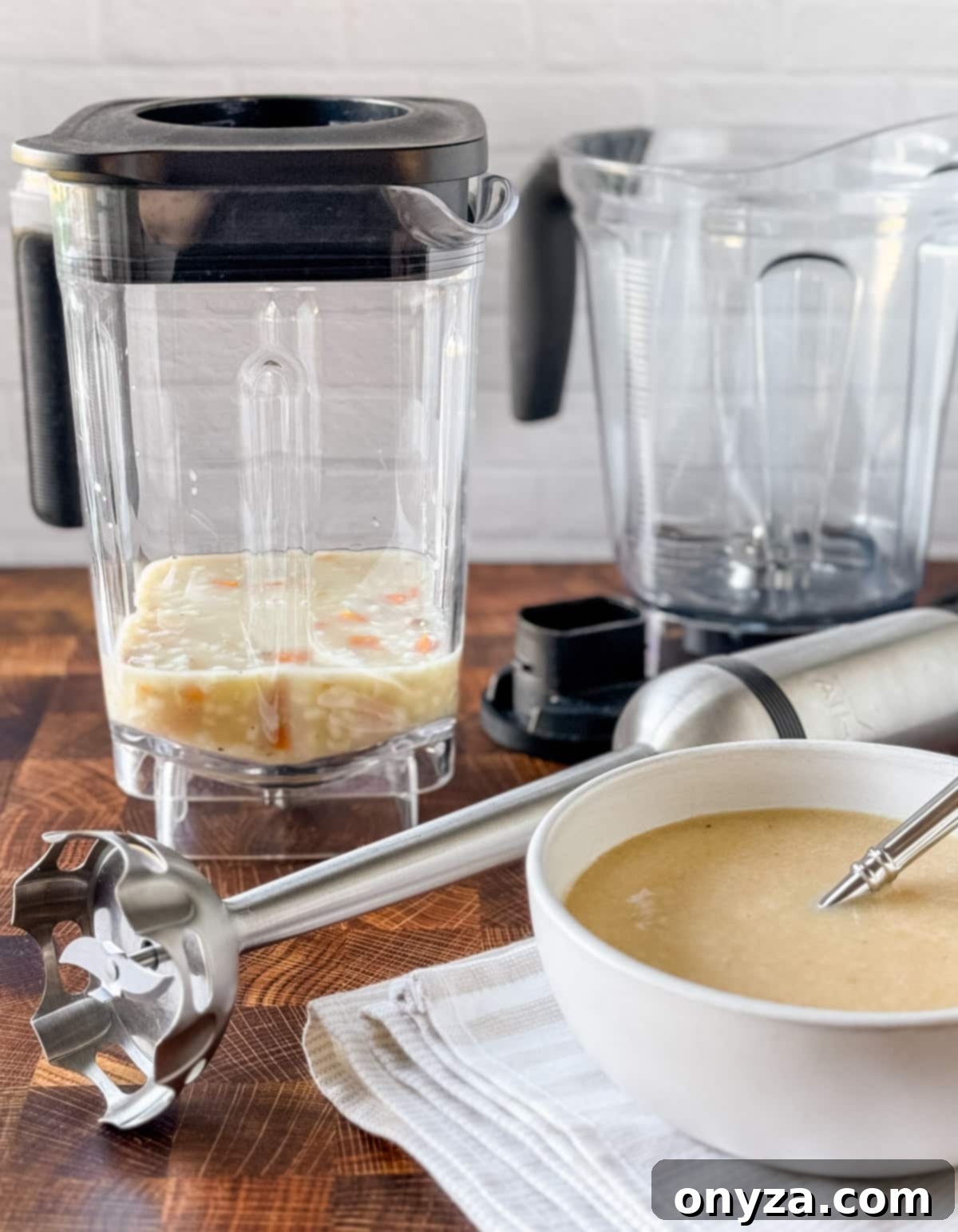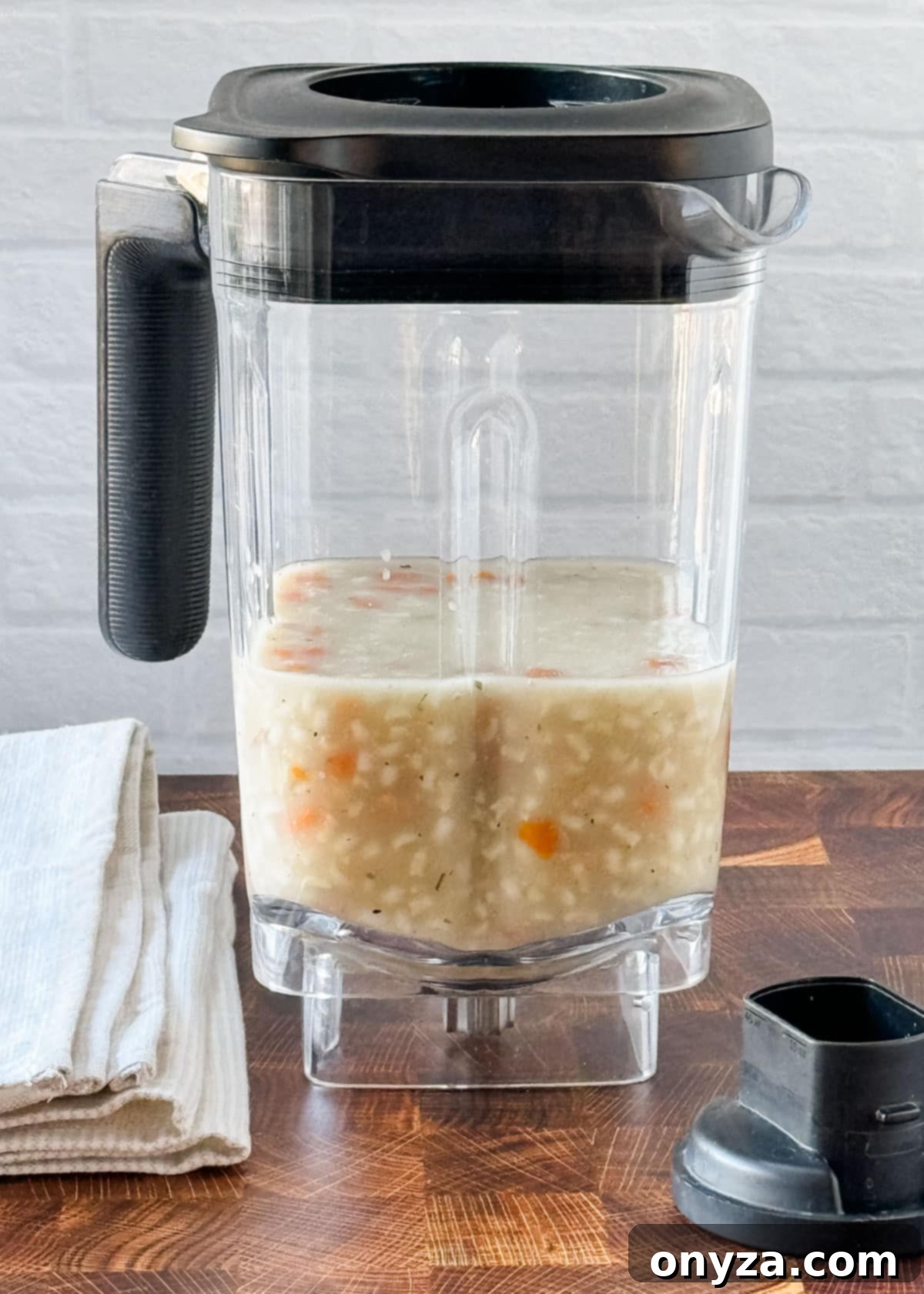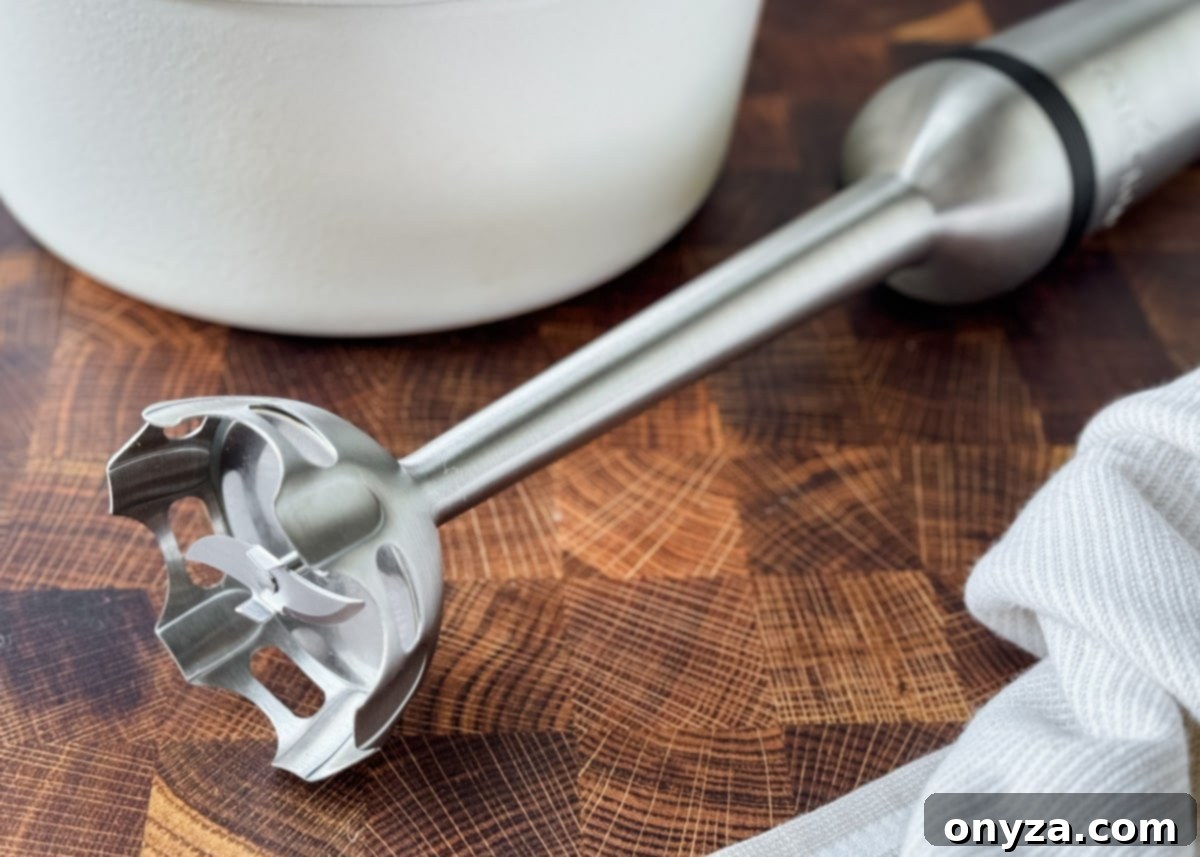For home cooks who cherish creating rich, flavorful cream soups, decadent sauces, and smooth purees, the process often involves one critical step: blending liquids while they’re still hot. This technique is essential for achieving that silky-smooth texture coveted in many culinary masterpieces. However, as many experienced chefs and home cooks can attest, blending hot liquids is a task that demands utmost caution. The kitchen can quickly become a hazardous environment if proper safety measures are not observed. This comprehensive guide will equip you with essential knowledge and practical tips to safely and effectively blend hot liquids, ensuring your culinary adventures remain enjoyable and accident-free. Whether you’re a seasoned cook or just starting your journey, understanding these best practices is key to confidently handling any recipe that calls for pureeing hot ingredients.

This post contains affiliate links. As an Amazon Associate, I earn a commission (at no additional cost to you) from qualifying purchases made by clicking these links. As always, all recommendations and opinions expressed are my own.
Understanding the Risks: Why Blending Hot Liquids Can Be Dangerous
The internet is rife with cautionary tales – and sometimes even dramatic videos – of blender mishaps involving hot liquids. These incidents often depict blender lids forcefully detaching and hot contents erupting across kitchen walls, cabinets, and sometimes, unfortunately, people. While these stories can be amusing in retrospect, they underscore a serious safety concern rooted deeply in basic scientific principles. Understanding these principles is the first step toward preventing such occurrences in your own kitchen.
The core reason behind these explosive reactions lies in the fundamental differences in how hot liquids behave compared to their room-temperature or cold counterparts when subjected to the rapid agitation of a blender.
Firstly, as liquids absorb heat and their temperature rises, they undergo a process of thermal expansion. This means their volume increases. When these expanded hot liquids are then placed into a blender, the high-speed blades introduce a significant amount of air into the mixture. This aeration further contributes to the overall volume of the liquid. The combination of thermal expansion and air incorporation creates an environment where the liquid’s volume can quickly exceed the capacity of the blender jar, even if it initially appeared adequately filled. The immediate consequence of this can be messy overflows, but more critically, it poses a severe risk of hot liquid splattering, leading to painful and potentially serious burns.
Secondly, and perhaps most dangerously, hot liquids release steam. When a hot liquid is contained within a sealed environment, such as a blender jar with its lid firmly in place, this steam has no escape. As the blender operates, the temperature of the liquid may even increase slightly due to friction, generating even more steam. This trapped steam rapidly builds up pressure inside the blender. If this pressure becomes too great, it can overcome the seal of the lid, causing it to pop off – often with considerable force. The sudden release of pressure, coupled with the violent churning of the blades, can propel scalding hot contents outwards, turning your kitchen into a hazard zone and putting anyone nearby at risk of severe burns and injuries.
Seeking inspiration for blended soups? Delight your palate with our reader-favorite Homemade Cream of Mushroom Soup or the comforting Creamy Roasted Tomato Soup.

Mastering the Countertop Blender: Safety Techniques for Hot Liquids
A traditional countertop blender, whether a standard model or a high-speed professional unit, is an indispensable tool for achieving perfectly smooth textures. However, when working with hot liquids, special attention to safety is paramount. Follow these detailed tips to ensure a safe and effective blending experience every time.
- Allow Liquids to Cool Before Blending. This is perhaps the most crucial safety step. Before transferring any hot liquid to your blender, give it ample time to cool down significantly. Aim for a temperature where the liquid is still warm but no longer actively steaming or boiling vigorously. Blending liquids that are at a rolling boil or near-boiling point dramatically increases steam production and the risk of dangerous pressure build-up. While a specific temperature might vary by recipe, a general rule is to wait until you can comfortably touch the exterior of the pot or container. Always consult your blender’s manual, as some models specify a maximum safe temperature for liquids. This initial cooling period significantly mitigates the risk of sudden pressure release.
- Never Overfill the Blender Jar. When blending hot or even warm liquids, it’s imperative to fill the blender container no more than halfway. This critical headspace provides sufficient room for the liquid to expand due to heat and aeration during the blending process. Overfilling the jar, even slightly, leaves no room for this expansion, making overflows almost inevitable. These overflows not only create a substantial mess but also pose a serious burn risk as hot liquid can splash out from under the lid or through any openings. Adhering to the halfway mark is a simple yet highly effective preventative measure against kitchen accidents.
- Properly Vent the Blender. Most countertop blenders are designed with a removable cap or plug located in the center of the lid, covering a filler hole. This design feature is vital for blending hot liquids. Some advanced models, like Vitamix blenders, feature specifically vented plugs that allow steam to escape while remaining in place. If your blender has a vented plug, confirm its functionality by checking your product manual. If your blender’s plug is not vented, or if you’re unsure, it is essential to remove this plug before you begin blending hot liquids. To prevent scalding hot splatters, cover the open filler hole with a folded kitchen towel. This technique allows steam to safely escape, preventing dangerous pressure accumulation, while the towel acts as a protective barrier against any errant splashes.
- Securely Hold Down the Blender Lid. Even with venting, it is a non-negotiable safety practice to firmly hold the blender lid in place with one hand throughout the blending process. Ensure the entire lid is securely seated on the blender jar before you start. To add an extra layer of protection, especially when the filler cap is removed for venting, drape a thick, folded dishtowel over the top of the lid and the open filler hole. This provides a physical barrier between your hand and any potential hot splashes or steam bursts. Holding the lid down steadfastly prevents it from dislodging due to the powerful blending action or any residual pressure build-up, giving you greater control and safety.
- Initiate Blending on the Lowest Speed Setting. The initial moments of blending hot liquids are often the riskiest. To minimize the chances of sudden splashes or rapid pressure build-up, always start your blender on the absolute lowest speed setting. This gentle start allows the liquid to begin circulating and breaking down gradually, without the immediate, violent agitation that higher speeds can cause. Once the liquid appears to be blending smoothly and without incident, you can progressively increase the speed, adjusting it as needed, until you achieve the desired smooth consistency for your soup or sauce.
- Maintain Consistent Monitoring. Do not set the blender and walk away. During the entire blending cycle, it is crucial to remain present and pay close attention to the blender’s operation. Listen for any unusual sounds from the motor, and visually observe the lid and jar for any signs of movement or stress. If you are using the folded towel method over the filler hole, you might feel the build-up of steam pressure against your hand. Should you detect any indication of excessive pressure, lid movement, or strain on the motor, immediately switch off the blender. Allow the contents to settle and cool further before carefully attempting to resume blending.
- Power Off and Allow Settling Time. Once your hot liquid has reached its desired velvety smoothness, resist the urge to immediately remove the lid. First, turn off the blender completely. Then, wait for a moment, perhaps 10-15 seconds, to allow the liquid to settle, any residual pressure to dissipate, and for the blades to come to a complete stop. This brief pause significantly reduces the risk of hot liquid splashing or steam escaping forcefully when the lid is eventually removed.
- Exercise Extreme Caution When Pouring. The blender jar itself can become very hot from the internal liquid, making it difficult to handle directly. To protect your hands from potential burns, always use oven mitts or a thick kitchen towel to securely grip the blender jar when pouring the blended contents. Pour the hot liquid slowly and deliberately into your designated container, such as another pot or a serving bowl, to prevent any accidental splashes or spills. Ensure your receiving container is stable and positioned on a flat, non-slip surface.
- Blend in Manageable Batches. For recipes that call for pureeing large quantities of soup, sauce, or other hot liquids, it is always safer and more effective to work in smaller batches. Attempting to blend an entire large pot of liquid at once, even if staying below the halfway mark, increases the risk of pressure build-up and makes monitoring more challenging. Blending in batches not only enhances safety by reducing the volume of hot liquid in the blender at any given time but also contributes to a superior end product. Smaller batches allow for more uniform blending, ensuring an even, consistent texture throughout, and prevent overworking or overheating your blender’s blades and motor, thus prolonging the appliance’s lifespan.
Considering an upgrade for your kitchen? We are long-time fans of our Vitamix Professional Series Blender {affilliate link}. While our specific model is older, it shares the same robust design and exceptional performance. We’ve relied on it for over a decade, and it continues to deliver perfectly smooth results as reliably as the day we bought it.

The Versatile Immersion Blender: Safe Practices for Hot Liquids
The immersion blender, affectionately known as a “stick blender,” is a truly versatile and highly convenient kitchen gadget. Its unique compact design allows you to blend directly within the cooking pot, eliminating the need for transferring hot liquids between containers. This direct blending capability minimizes mess and streamlines the pureeing process, making it a favorite for thick soups and sauces.
While a high-speed countertop blender often yields the most exquisitely velvety purees, immersion blenders are excellent for achieving a fairly smooth consistency with less hassle. They are particularly adept at creating rustic-style purees or breaking down ingredients in a large pot. Despite their convenience, immersion blenders also require specific safety considerations when handling hot liquids.
- Confirm All Attachments Are Securely Affixed. Before you even plug in your immersion blender, it is critically important to double-check that all components, especially the blending arm and any other attachments, are securely and correctly locked into place. A loosely attached blending arm can detach during operation, not only damaging the appliance but also sending hot liquid splashing dangerously. A quick twist or click to ensure everything is firm will prevent potential accidents.
- Ensure Adequate Pot Depth for Submersion. The depth of your cooking pot or container is crucial when using an immersion blender. Always ensure that the pot is deep enough to fully submerge the head of the stick blender, covering the blades. Operating the blender with the blades only partially submerged drastically increases the likelihood of hot liquid splashing violently out of the pot. The goal is to keep the blending action entirely below the surface of the liquid, containing any turbulence within the pot.
- Adhere to Maximum Fullness Guidelines. Even with an immersion blender, the concept of not overfilling applies. Avoid using an immersion blender in a pot that is filled to the brim. A practical guideline is to keep the liquid level no higher than two-thirds (2/3) of the pot’s total capacity. This remaining headspace is essential to accommodate any minor expansion of the liquid and to prevent splashing when the blender is first activated or moved around. It provides a safety margin against accidental overflows.
- Utilize Tilting for Enhanced Efficiency. If you are working with a wider pot that makes it challenging to thoroughly submerge the blender head and achieve a consistent blend, a slight tilt can be very helpful. Carefully tilting the pot can gather the liquid to one side, creating a deeper pool for better immersion and more effective blending. However, only attempt this if the pot is cool enough to handle safely. Additionally, moving the immersion blender at a slight angle within the liquid, rather than strictly vertically, can promote a smoother flow of the liquid around the blades, contributing to a more even and consistent puree.
- Start with Gentle Pulses, Then Increase Speed. To minimize initial splatter and gain better control, begin the blending process by using a few short, gentle pulses rather than immediately engaging a continuous high speed. This helps to break down larger chunks of ingredients gradually and reduces the sudden displacement of hot liquid. Once the larger solids are reduced and the liquid begins to circulate, you can then transition to a continuous low speed, gradually increasing it as necessary to achieve your desired smoothness, similar to the technique used with a countertop blender.
- Employ a Sweeping Motion for Uniform Blending. An immersion blender is designed to be moved, not kept static. Instead of holding the blender in one spot, use a slow, controlled sweeping motion throughout the pot. Move the blender up and down, and around the perimeter, ensuring all parts of the liquid are processed. Crucially, never lift the head of the immersion blender above the surface of the liquid while it is turned on, as this will inevitably lead to hot splatters. Keep the blades fully submerged until the appliance is turned off.
- Avoid Forcing the Blender Against the Pot Bottom. While the aim is thorough blending, avoid pressing the immersion blender’s head firmly against the bottom of the pot. Doing so can scratch non-stick surfaces or delicate pot materials if the blade guard doesn’t offer full protection. More importantly, forceful downward pressure can create a vacuum effect or push hot liquid outwards and upwards, leading to unexpected splashes and potential burns. Allow the blades to work freely within the liquid without unnecessary pressure against the pot’s base.
- Pre-Cool Liquids Slightly Even for Immersion Blenders. Although immersion blenders are generally considered safer for hot liquids than countertop blenders due to their direct-in-pot use, it’s still a prudent safety measure to let very hot liquids cool down a little before blending. Reducing the initial temperature helps to mitigate excessive steam generation and the risk of hot splashes. As with countertop blenders, avoid using an immersion blender on actively boiling or near-boiling liquids. A waiting period of 10-20 minutes, depending on the initial temperature of the liquid, is often sufficient to bring it to a safer, still-hot-but-manageable temperature.
In the market for a new stick blender? Our current top recommendation for its reliability and performance is the Braun Multiquick 5 Immersion Hand Blender {affiliate link}. It’s a fantastic tool for any kitchen.
Universal Safety Measures for Blending Hot Liquids
Beyond the specific techniques for countertop and immersion blenders, there are overarching safety practices that apply to any scenario involving blending hot liquids. Adhering to these general guidelines will further enhance your protection in the kitchen.
- Don Protective Gear. Your personal safety should always be the top priority. When blending hot liquids, consider wearing protective gear. An apron can shield your clothing and skin from unexpected splashes. Oven mitts or heat-resistant gloves are essential for handling hot blender jars or pots. For an extra layer of caution, especially when blending very hot liquids, some individuals opt for long sleeves and even safety glasses to protect their eyes from any potential steam or liquid bursts.
- Maintain a Safe Distance and Clear View. Always keep your face and any exposed skin well away from the top opening of the blender or the pot you’re working in. This is crucial to avoid direct exposure to hot splashes and the sudden release of steam. Be particularly vigilant when it comes time to remove the lid from a countertop blender after blending, as residual pressure can cause a puff of scalding steam to escape quickly. Never peer directly into the blender while it’s operating.
- Ensure a Stable and Secure Workspace. The foundation of any safe kitchen operation is a stable work surface. Always place your countertop blender on a flat, even, and sturdy surface. If your kitchen counter is wet or oily, thoroughly wipe it dry before positioning the blender to prevent any accidental slips or movements during operation. When using an immersion blender, ensure the pot is resting firmly on a stable surface. For added security and to protect your countertops from heat and scratches, consider placing the pot on a silicone trivet {affilliate link} or a non-slip mat. This helps to anchor the pot and prevent it from shifting while you’re actively blending.
Disclaimer: The safety tips and best practices outlined in this article are provided as general guidance for blending hot liquids and are not exhaustive. Kitchen appliances can vary significantly, and individual circumstances may require additional precautions. It is always imperative to use your best judgment and to thoroughly familiarize yourself with your specific blender’s safety guidelines and operating instructions, as provided in its product manual. Some blender models may feature unique safety steps, advanced features, or specific instructions for safely managing steam and internal pressure that are crucial for their safe operation.
